Different Types of Leaves: Identification and Characteristics
Estimated reading time: 13 minutes
Learning about different types of leaves is important to see the many forms and functions of leaves on flowering plants. We can group leaves as simple or compound. Compound leaves have leaflets, two or more small leaves, on one stem. A simple leaf is a single leaf. Palmately compound leaves have leaflets that spread out from one spot at the leaf base. Pinnately compound leaves have leaflets lined up along a main stem. How leaves grow on a plant stem is called phyllotaxy. This includes leaves across from each other and leaves that switch sides. Leaf venation is the pattern of veins in a leaf. It can be like a feather or a hand. Knowing these parts helps us understand how plants changed over time and how they fit into different places.
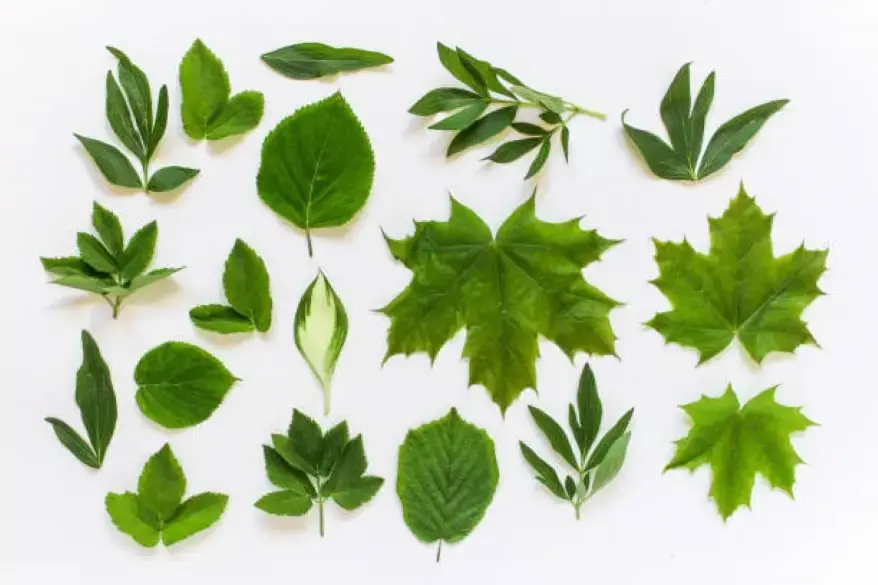
Leaves are very important for making food, moving air, and controlling water. Different leaf shapes and sizes, like long or big leaves, can help leaves get more sun. Small parts at the leaf base can also change how a leaf looks.
Also, a group studies leaf structure to learn about what leaves do in nature. For example, some leaves fall off when the weather changes. Thus, this shows they can adjust. The many leaf shapes, like tiny leaves or sharp spines, help keep ecosystems healthy. Therefore, this makes it important to study different leaves in plant science.
Fundamental Leaf Structures
Basic leaf parts help us know the different kinds of leaves on plants with flowers. A simple leaf has one blade. Compound leaves have types. Pinnate leaves have small leaves along a central line. Palmate leaves have small leaves joined at one spot. The way leaves grow on a stem, called phyllotaxy, can be in pairs or one at a time. However, this changes the amount of light each leaf gets. Each leaf has a different surface that feels and looks different. Leaf lines show how the veins are made, like pinnate or palmate. Some leaves may have stipules, small bits at the base, or become spines to guard the plant.
How big leaves are and what shape they have matters to plants. It changes how they get food and save water. For instance, a big leaf can help grab more light, while long leaves can waste less water. Moreover, the number of leaves on a plant can change a lot, and affects how well it grows. Different leaves often fall off when the weather changes, which is a key part of a plant’s life.
The leaf architecture working group studies the intricate designs of leaves, revealing how different structures contribute to a plant’s success in its habitat.
Simple vs. Compound Leaves
Simple Leaves:
- Definition:
- A simple leaf has a single, undivided leaf blade.
- It may have lobes, but the leaf blade remains one continuous piece.
- Characteristics:
- A single leaf blade.
- A single axillary bud at the leaf’s base.
- Examples:
- Maple leaves, oak leaves, and apple leaves.
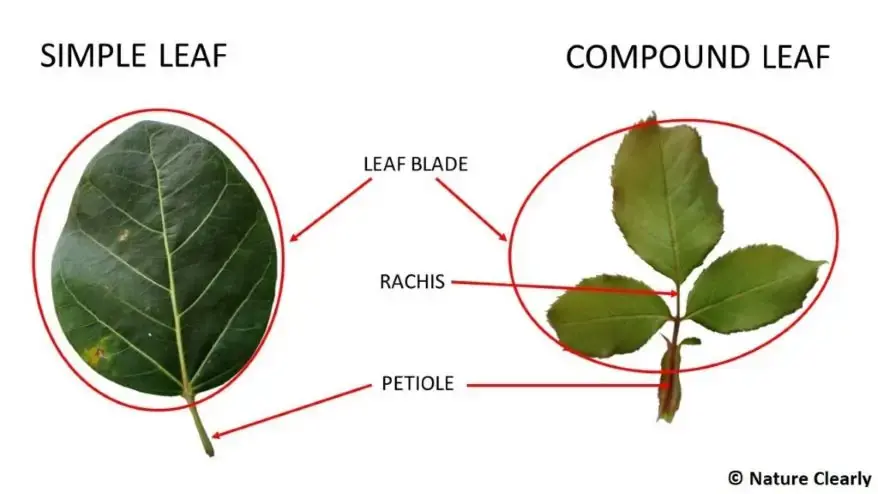
Compound Leaves:
- Definition:
- A compound leaf is divided into multiple separate leaflets.
- Each leaflet may appear like a small leaf itself.
- Characteristics:
- The leaf blade is divided into distinct leaflets.
- Leaflets are attached to a common petiole or rachis.
- No axillary buds at the base of leaflets, only at the base of the entire compound leaf.
- Types:
- Pinnately compound: Leaflets arranged along a central axis (rachis), like in roses or ash trees.
- Palmately compound: Leaflets radiate from a central point, like in horse chestnuts.
- Examples:
- Rose leaves, walnut leaves, and clover leaves.
Key Difference:
- The most important differentiating factor is the presence of a single, undivided blade in simple leaves versus the division of the blade into multiple leaflets in compound leaves. Also, the location of the axillary bud is key.
Essentially, it’s about whether the leaf blade is a single piece or divided into separate parts.
Leaf Venation Patterns
Leaf venation patterns refer to the arrangement of veins within a leaf, which transport water and nutrients throughout the leaf blade. These patterns are crucial for the leaf’s function and are a key characteristic in plant classification. Here’s a breakdown of the main types:
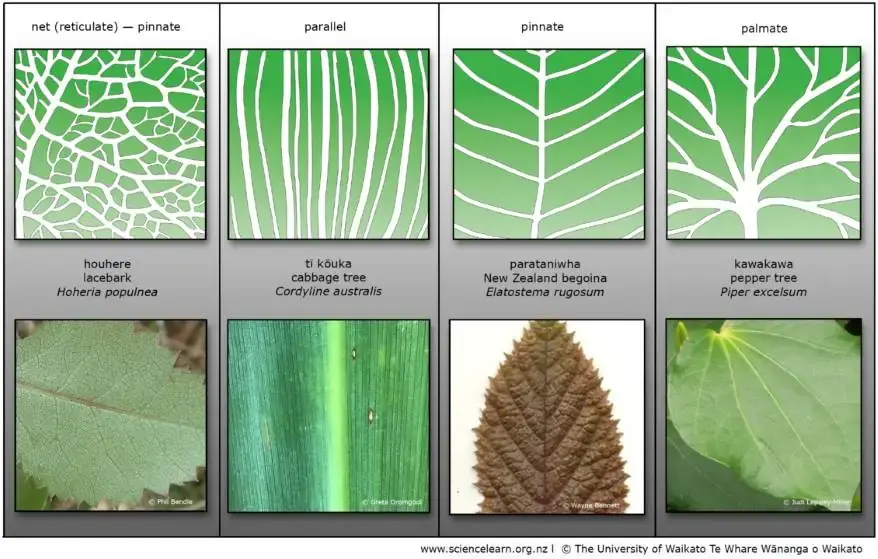
1. Reticulate Venation (Netted Venation):
- Description:
- A network of interconnected veins that form a web-like pattern.
- Veins branch out repeatedly, creating a complex, irregular network.
- Characteristics:
- Common in dicotyledonous plants (dicots).
- Provides efficient distribution of water and nutrients.
- Offers structural support to the leaf.
- Examples:
- Oak leaves, maple leaves, and rose leaves.
2. Parallel Venation:
- Description:
- Veins run parallel to each other along the length of the leaf.
- Veins may be connected by small, perpendicular cross-veins.
- Characteristics:
- Common in monocotyledonous plants (monocots).
- Provides a linear flow of water and nutrients.
- Often seen in long, narrow leaves.
- Examples:
- Grass leaves, corn leaves, and banana leaves include in different types of leaves.
3. Dichotomous Venation:
- Description:
- Veins repeatedly fork into two equal branches.
- Because, no network of interconnecting veins.
- Characteristics:
- Less common than reticulate or parallel venation.
- Found in some plants.
- Also, provides a simple, branching pattern.
- Example:
- Ginkgo leaves.
Importance:
- Venation patterns are a valuable tool for plant identification and classification.
- They reflect the evolutionary history and adaptations of different plant groups.
- Furthermore, they provide the necessary structure to support the leaf blade.
Different types of leaves: Margins and Shapes
Leaf edges and forms are important for telling apart the leaves of flowering plants. The flat part of the leaf comes in different shapes. Simple leaves have one part, while compound leaves have several smaller parts joined to a stalk. In one kind of compound leaf, the small parts are on both sides of a central line. In another kind, they spread out from one spot. Leaves grow on stems in different ways, either across from each other or taking turns. Additionally, this affects how much sun the leaf gets. Different patterns of veins also make leaves look different. Eventually, some plants lose their leaves at certain times of the year.
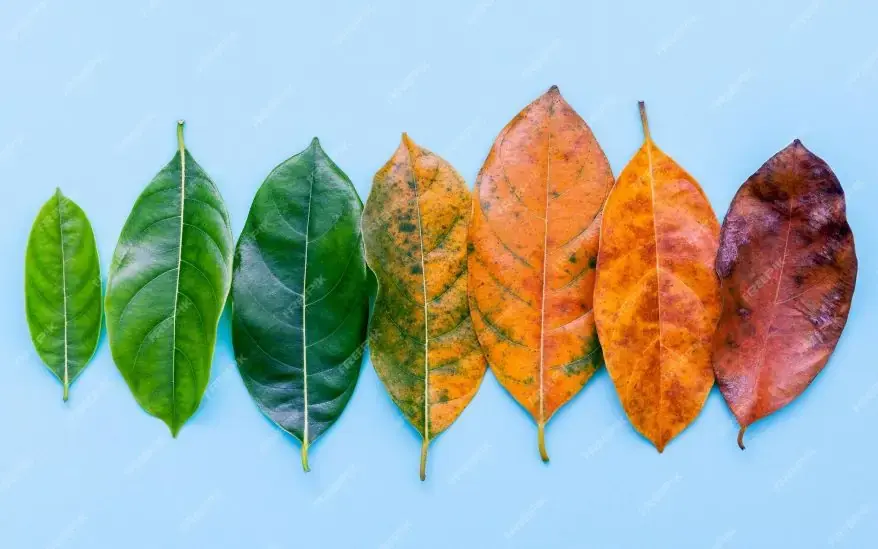
Leaves come in different shapes. Also, some are thin, others are wide. How many of leaves a plant has affects its growth. In fact, big leaves help plants make food well. Some plants have leaves that start at one point and look like a hand. The bottom of a leaf may have small parts or pointy edges. Hence, these help protect the plant and keep it upright. Further, experts study leaf shapes to learn how they changed and what they do.
Leaf Arrangements (Phyllotaxy)
Leaf arrangement, or phyllotaxy, refers to the pattern in which leaves are arranged on a plant stem. Whereas, this arrangement is not random; it’s a strategic design to maximize sunlight exposure and minimize shading between leaves. Here are the main types:
1. Alternate (Spiral) Arrangement:
- Description:
- One leaf is present at each node, and the leaves alternate sides of the stem.
- This often creates a spiral pattern as you move up the stem.
- Characteristics:
- Reduces shading by spacing leaves effectively.
- Also, common in many plant species.
- Examples:
- Oak, apple, and rose plants.
2. Opposite Arrangement:
- Description:
- Two leaves are present at each node, positioned directly opposite each other.
- Characteristics:
- Creates a symmetrical pattern.
- Moreover, common in plants like maples and mints.
- Examples:
- Maple, mint, and lilac plants.
3. Whorled Arrangement:
- Description:
- Also, three or more leaves are present at each node, arranged in a circle or whorl around the stem.
- Characteristics:
- Less common than alternate or opposite arrangements.
- Also, provides a dense leaf distribution.
- Examples:
- Oleander and horsetail plants.
4. Rosette Arrangement:
- Description:
- Leaves are clustered in a basal rosette at the base of the plant.
- Also, internodes (stem segments between nodes) are very short, resulting in a tight cluster.
- Characteristics:
- Often found in plants that grow close to the ground.
- In fact, it helps to conserve moisture and protect the plant.
- Examples:
- Dandelions and lettuce.
Importance of Phyllotaxy:
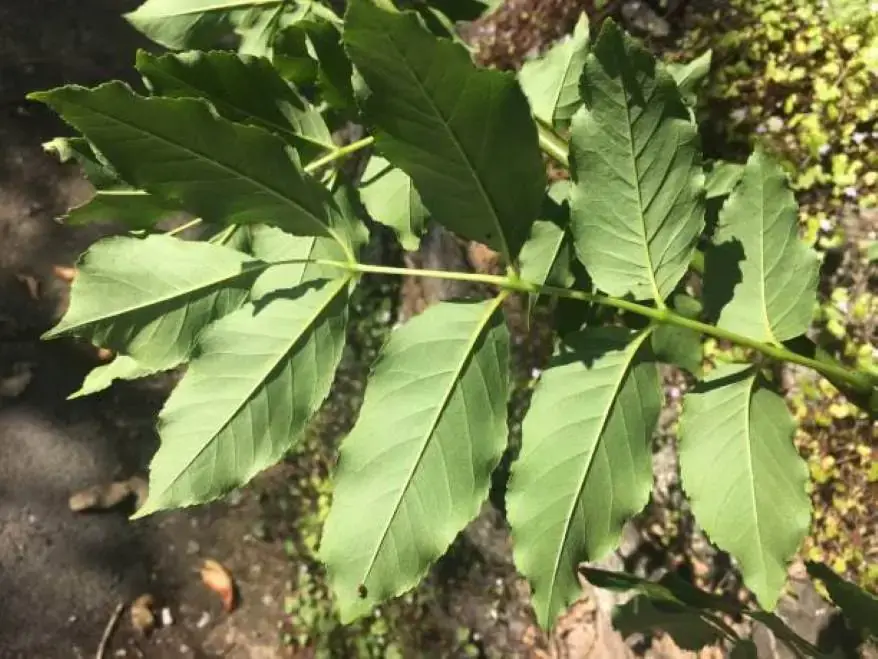
- Light Capture: Additionally, it maximizes sunlight exposure for photosynthesis.
- Air Circulation: Moreover, it allows for adequate air flow around leaves.
- Reduced Shading: Furthermore, it prevents upper leaves from shading lower ones.
- Plant Identification: Also, phyllotaxy is a key characteristic used in plant identification and classification.
Specialized Leaf Adaptations
Whereas specialized leaf adaptations play a crucial role in the survival and efficiency of flowering plants. Leaves are either simple or compound. Simple leaves have one leaf part. Compound leaves have more than one smaller leaf attached to a stalk. For example, in one type of compound leaf, smaller leaves grow along the main center part. In another type, the smaller leaves spread out from one spot.
Also, the base of the leaf and its connection to the stem matter for how the leaves are arranged. In fact, leaves can be arranged across from each other or in circles around the stem. Moreover, the size and look of a leaf depend on its surroundings. For example, some leaves have sharp edges to stop animals from eating them. Other leaves are large to collect lots of sunlight.
Leaf veins can resemble tree branches stemming from a central line or radiating from a point. Because researchers examine these variations to understand how leaves maximize sunlight use. Whereas, plants in dry environments often have narrow or small leaves to reduce water loss. Conversely, plants in warm, moist environments might have broad leaves to capture more sunlight. Over time, leaves adapt, enabling plants to thrive in diverse habitats. Also, many leaves drop seasonally to conserve energy. Therefore, the variety of leaf types highlights plants’ remarkable ability to adapt to their surroundings.
Identifying and Classifying different types of Leaves
Identifying and classifying leaves is a fascinating and practical skill, essential for botany enthusiasts, nature lovers, and anyone interested in plant life. So, here’s a breakdown of the key aspects:
1. Key Characteristics to Observe in different types of leaves:
- Leaf Type:
- Simple or compound.
- Leaf Venation:
- Additionally, reticulate (netted), parallel, or dichotomous.
- Leaf Margins:
- Also, entire (smooth), serrate (toothed), lobed, etc.
- Leaf Shape:
- Furthermore, ovate, lanceolate, cordate, etc.
- Leaf Arrangement (Phyllotaxy):
- While, alternate, opposite, whorled, or rosette.
- Leaf Texture:
- Smooth, hairy, rough, etc.
- Leaf Color:
- Variations in green, and also other colors.
- Presence of other features:
- e.g., spines, or other modifications.
2. Classification Process of different types of leaves:
- Start with the Basics:
- Determine if the leaf is simple or compound.
- Still, identify the venation pattern.
- Examine the Details:
- Pay close attention to the leaf margins and thus shape.
- So, note the leaf arrangement on the stem.
- Use Resources:
- Field guides, botanical keys, and online resources can be invaluable tools.
- Also, apps that help identify plants through photos.
3. Tools and Resources:
- Field Guides:
- Also, regional field guides provide detailed descriptions and illustrations of local plants.
- Botanical Keys:
- Thus, these are systematic tools that use a series of paired statements to guide identification.
Why It’s Important:
- Understanding Biodiversity:
- Additionally, leaf identification helps us appreciate the diversity of plant life.
- Ecological Awareness:
- So, it allows us to understand the relationships between plants and their environments.
- Practical Applications:
- It’s useful for gardening, foraging, and other outdoor activities.
- Scientific Study:
- Thus, it’s fundamental for botanical research and conservation.
The Functions of Different Types of Leaves
Different types of leaves are essential organs for plants, performing a variety of crucial functions that enable plant survival and growth. Thus, here’s a breakdown of their primary roles:

1. Photosynthesis:
- This is the most fundamental function. Leaves contain chlorophyll, a pigment that captures light energy from the sun.
- This light energy is used to convert carbon dioxide and water into glucose (a type of sugar) and oxygen.
- Furthermore, glucose serves as the plant’s food source, providing energy for growth and other metabolic processes.
- Also, oxygen is released as a byproduct.
2. Gas Exchange:
- Leaves have tiny pores, called stomata, on their undersides.
- Also, stomata allow for the exchange of gases:
- Carbon dioxide also, is taken in for photosynthesis.
- Thus, oxygen is released as a byproduct of photosynthesis.
- Water vapor is released during transpiration.
3. Transpiration:
- Transpiration is the process by which water evaporates from the leaf surface.
- Whereas, this creates a “pull” that helps draw water and nutrients up from the roots to the rest of the plant.
- It also helps to cool the plant.
4. Senescence and Nutrient Recycling:
The process of leaves changing color and dropping from trees, often associated with aging, involves the tree reclaiming vital nutrients from the leaves for storage. Subsequently, these fallen leaves decompose and enrich the soil. In essence, leaves function as plant factories, facilitating energy production, gas exchange, and water regulation. Additionally, they serve as storage sites, contribute to plant defense, and play a role in plant reproduction.
Conclusion:
Leaf morphology, encompassing shape, size, venation, and texture, reflects a plant’s adaptation to its environment. This diversity is crucial for photosynthesis, water regulation, and defense. Moreover, studying leaf morphology aids in plant identification, ecological research, and understanding evolutionary relationships. Therefore, it highlights the intricate connection between a leaf’s form and its functional role in a plant’s survival.
FAQ’s:
1. What is the basic morphology of different leaves?
- Leaf Blade (Lamina): The flat, expanded portion, thus, the primary site of photosynthesis.
- Petiole: Also, the stalk that connects the leaf blade to the stem. Some leaves are sessile (lacking a petiole).
- Veins: Vascular tissue (xylem and phloem) whereas that transports water and nutrients, providing structural support.
- Leaf Apex: Thus, the tip of the leaf.
- Leaf Base: The part of the leaf that connects to the petiole or stem.
- Stomata: Small pores on the leaf’s surface, primarily on the underside, for gas exchange.
2. What are the different types of leaves?
- Simple Leaves: A single, also undivided leaf blade.
- Compound Leaves: Additionally, the leaf blade is divided into multiple leaflets.
- Pinnately Compound: The leaflets are arranged along a central axis (rachis).
- Palmately Compound: Whereas, leaflets radiate from a central point.
- Based on Venation:
- Reticulate (Netted): A network of branching veins.
- Parallel: Veins run parallel to each other.
- Dichotomous: Thus, veins repeatedly fork into two.
- Based on Adaptations:
- Thus, succulent leaves (water storage).
- Also, spines (defense).
- Additionally, leaves are modified for trapping insects.
3. How are leaves arranged on a stem?
- Alternate (Spiral): One leaf per node, alternating sides of the stem.
- Opposite: Also, two leaves per node, directly across from each other.
- Whorled: Moreover, three or more leaves per node, arranged in a circle.
- Rosette: Additionally, leaves are clustered at the base of the plant.
4. What is the significance of leaf margins?
- Identification: Leaf margins are a key characteristic for plant identification.
- Adaptation:
- Smooth margins (entire) are common in warmer climates.
- Indeed, toothed margins (serrate) can influence water runoff.
- Also, lobed margins can help to dissipate heat and keep the leaf cooler.
- Protection: Some margins have spines or teeth for defense against herbivores.
- Water management: The shape of the margin can dictate how water runs off the leaf.
References
- Yang, S., Liu, Y., Wang, S., Peng, H., Hui, X., & Yang, A. (2024). Causal relationship between circulating inflammatory proteins and risk of different types of encephalitis: A two-sample Mendelian randomization study. Cytokine, 184, 156789. https://doi.org/10.1016/j.cyto.2024.156789
- Dossou, S. S. K., Deng, Q., Li, F., Wang, L., Jiang, N., Kefale, H., Zhou, R., Li, D., Tan, M., & Wang, L. (2025). Metabolic profiling of Perilla leaves of different colors: insights into metabolite variation and bioactive compound distribution. BMC Plant Biology, 25(1). https://doi.org/10.1186/s12870-024-05984-8
- Conklin, P. A., Strable, J., Li, S., & Scanlon, M. J. (2018). On the mechanisms of development in monocot and eudicot leaves. New Phytologist, 221(2), 706–724. https://doi.org/10.1111/nph.15371
- Muraleedharan, V., Rajan, S. C., & R, J. (2024). Geometric entropy of plant leaves: A measure of morphological complexity. PLoS ONE, 19(1), e0293596. https://doi.org/10.1371/journal.pone.0293596
Additionally, to stay updated with the latest developments in STEM research, visit ENTECH Online. Basically, this is our digital magazine for science, technology, engineering, and mathematics. Further, at ENTECH Online, you’ll find a wealth of information.





